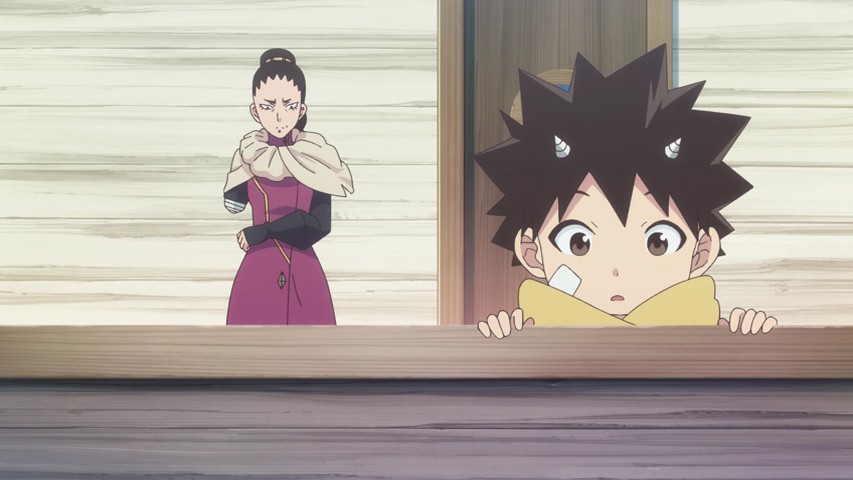 While I would argue that Fall 2018 isn’t an especially interesting anime season on-screen (certainly not by historical standards), it has turned out to be kind of interesting in terms of the business and fandom of anime. We have a mix of good shows that are being totally ignored (like this one), two highly popular LN adaptations with diametrically opposed world-views vying for supremacy (the wrong one seems to be winning), and then there’s SSSS.Gridman. I noted last week that both it and Radiant were getting terrible aggregator scores, but the similarity ends there – Gridman is clearly resonating with Japanese fans, even if it’s often for what I would call the wrong reasons. It’s divisive, yes, but unless pre-sale (I guess we can’t call them stalker anymore) numbers are historically whack, it’s going to be a major commercial success.
While I would argue that Fall 2018 isn’t an especially interesting anime season on-screen (certainly not by historical standards), it has turned out to be kind of interesting in terms of the business and fandom of anime. We have a mix of good shows that are being totally ignored (like this one), two highly popular LN adaptations with diametrically opposed world-views vying for supremacy (the wrong one seems to be winning), and then there’s SSSS.Gridman. I noted last week that both it and Radiant were getting terrible aggregator scores, but the similarity ends there – Gridman is clearly resonating with Japanese fans, even if it’s often for what I would call the wrong reasons. It’s divisive, yes, but unless pre-sale (I guess we can’t call them stalker anymore) numbers are historically whack, it’s going to be a major commercial success.
There seems little to no chance of that with Radiant, though without question it is being received better here than in most of the West (I’ll be interested in hearing how it goes over in France, but nothing much on that front yet) – it’s just not the sort of show that generally does well on disc. There was a rather interesting press event with the mangaka, Tony Valente, in New York this week in which he shed light on a few aspects of Radiant’s backstory:
- Murata Yusuke (One Punch Man, Eyeshield 21) was instrumental in getting Radiant published in Japan in 2015 and the two mangaka are mutual fans. Mashima Hiro (Fairy Tail) is also a big Radiant fan, which sort of fits as I see more of that series in Radiant than any other Japanese manga.
- Valente considers himself a huge Shounen Jump fan (duh).
- Valente wanted the story to mirror elements of European history, especially the Inquisition.
- Valente, while French, is not of fully French ancestry (his father emigrated from Portugal) and he wanted Radiant to focus on the scapegoating of those who are different from the majority (that could hardly be more timely, obviously).
- Valente consults on the scripts weekly, but does not provide any script material or drawings himself.
- The first half of the season contains considerable original material, while the second sticks much more closely to the source material.
 We’re certainly starting to see some of the historical elements come out in the story with this episode. In fact the Inquisition itself – not even the name was changed – makes an appearance, both by reference and physically. When Alma reminds Seth that “Nemesis aren’t our only enemies”, it’s pretty clear that it’s this she’s referring to. But Seth is nothing if not stubborn, and rather than accept that he’s going to be doing a thankless and dangerous job only to be reviled by most of the people he serves, he – in very shounen sense – determines to change the situation itself.
We’re certainly starting to see some of the historical elements come out in the story with this episode. In fact the Inquisition itself – not even the name was changed – makes an appearance, both by reference and physically. When Alma reminds Seth that “Nemesis aren’t our only enemies”, it’s pretty clear that it’s this she’s referring to. But Seth is nothing if not stubborn, and rather than accept that he’s going to be doing a thankless and dangerous job only to be reviled by most of the people he serves, he – in very shounen sense – determines to change the situation itself.
 The last point above is especially interesting to me, because if I have any complaint about the anime side of Radiant so far it’s that things seem to be moving quite quickly. I don’t know how much of that comes down to the changes that Valente refers to, since in reviews of the manga one comment I’ve seen is that the pacing is very quick right out of the gate. But there are things that are happening that don’t seem to be fully supported by events on-screen, and Seth’s decision to leave Alma – and her’s to allow him to – are among them.
The last point above is especially interesting to me, because if I have any complaint about the anime side of Radiant so far it’s that things seem to be moving quite quickly. I don’t know how much of that comes down to the changes that Valente refers to, since in reviews of the manga one comment I’ve seen is that the pacing is very quick right out of the gate. But there are things that are happening that don’t seem to be fully supported by events on-screen, and Seth’s decision to leave Alma – and her’s to allow him to – are among them.
 Given the clear inspiration for Radiant – classic manga and anime fantasy, yes, but also stuff like the Earthsea Trilogy and other YA fantasy novels – this development was pretty much a given to happen sooner or later. But while Seth certainly held his own admirably with the Nemesis this time, he was still toast if Alma hadn’t arrived just in the nick of time. And while the backstory was excellently done, what it did was cement the emotional bond between Alma and Seth as both real and deep – which made her decision to allow him to go off to search for Radiant (the legendary source of all Nemesis) on his own all the more seemingly premature.
Given the clear inspiration for Radiant – classic manga and anime fantasy, yes, but also stuff like the Earthsea Trilogy and other YA fantasy novels – this development was pretty much a given to happen sooner or later. But while Seth certainly held his own admirably with the Nemesis this time, he was still toast if Alma hadn’t arrived just in the nick of time. And while the backstory was excellently done, what it did was cement the emotional bond between Alma and Seth as both real and deep – which made her decision to allow him to go off to search for Radiant (the legendary source of all Nemesis) on his own all the more seemingly premature.
 It’s pretty clear that Valente has invented a pretty extensive mythology here, and things with the Nemesis and Inquisition are likely going to be more complex than they appear. Alma’s loss of memory is a sure sign that Seth’s past (and parentage) are going to be important factors before the story is done. I’m anxious to see all that play out, but I just with the story had taken a little more time to get us to this stage organically (and given us more time with Paku Romi, of course – though she’ll surely be back). Be that as it may, Radiant surely isn’t going to get triple-digit episode counts like Fairy Tail, so the fact that we’re jumping right into the meat of what sounds like a very interesting story may not be a bad thing.
It’s pretty clear that Valente has invented a pretty extensive mythology here, and things with the Nemesis and Inquisition are likely going to be more complex than they appear. Alma’s loss of memory is a sure sign that Seth’s past (and parentage) are going to be important factors before the story is done. I’m anxious to see all that play out, but I just with the story had taken a little more time to get us to this stage organically (and given us more time with Paku Romi, of course – though she’ll surely be back). Be that as it may, Radiant surely isn’t going to get triple-digit episode counts like Fairy Tail, so the fact that we’re jumping right into the meat of what sounds like a very interesting story may not be a bad thing.









































The wild guesser
October 21, 2018 at 11:30 amThe number one critique I’ve seen held against Radiant is that it is too “generic” and that the plot moves too slowly.
I won’t argue that Radiant isn’t groundbreaking, it certainly isn’t reinventing the wheel, but it’s got charm and an identity all its own.
I don’t understand how the pacing can be too slow, then again, I feel like Naruto pacing was normal back in the day, filler and all, so now the pendulum must’ve swung the other way.
In a stronger season Radiant might not have made itself into my to-watch list, but this isn’t a stronger season.
Simone
October 21, 2018 at 7:26 pmThe pendulum definitely has swung there. The biggest new shounen manga, namely BnHA, is getting an adaptation that follows completely different criteria from those of old: a bunch of seasons separated by pauses of six months or so instead of a single continuous run diluted by filler material. I would argue the quality has definitely benefited from that (One Piece is great, and I can’t stand to watch the One Piece anime any more).
However what happened here IMHO was also a slight departure from convention – usually the first episode of a shounen show is a self-contained story that works as an introduction to everyone and has a satisfying payoff on its own that shows off the protagonist’s power (Luffy defeating Alvida, Naruto defeating Mizuki, Ichigo defeating Generic Hollow #672, and so on). Here instead we had more of a 3-episode mini-arc to kick things off, which is somewhat abnormal. I think it could have been sped up a little, but not probably beyond fitting it into a 2.5 episode room.
Yi
October 22, 2018 at 2:23 amI really don’t see how Radiant getting a lukewarm reception is grounds for some sort of indictment of the fandom. It’s not a top ranked manga in Japan, so it doesn’t have a ready made fan base waiting for the anime. So far it’s not exceptional enough to distinguish itself from your typical shounen, which means that it’s going to have middling interest among shounen fans and little crossover appeal for the rest of the anime fandom. I think I already said this, but shounen is not for everyone, nor is it supposed to be. Even you seem to be selling Radiant more for “saving anime” political reasons than for its content. When you find yourself spending half of each episode review talking about how special the anime is supposed to be for theoretical reasons, you may have a bit of a problem.
Regarding “the wrong one” or Goblin Slayer winning, you were spectacularly quick to judge it based on the first episode. I’m perfectly fine without rape an pillage in my anime, but if it can be used for “grittiness” in Berserk without people bending over backwards to decry it, it can also be used in Goblin Slayer. I sure hope I won’t hear counterarguments about it being “gratuitous” in one and “necessary” in the other. In any case, the following episodes have toned things down and the show has settled into its D&D pattern. I’m going to keep watching both Goblin Slayer and Slime, it doesn’t have to be an either/or choice.
Come to think of it, the author of Goblin Slayer paying homage to Western D&D is really no different form Valente paying homage to Japanese shounen manga, so why treat only one of these cases as something special?